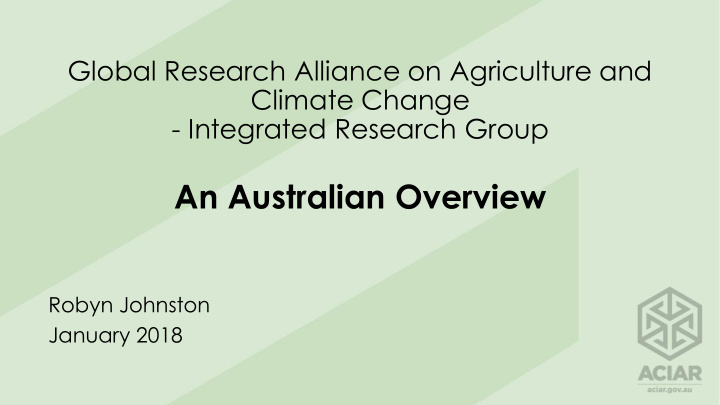



Global Research Alliance on Agriculture and Climate Change - Integrated Research Group An Australian Overview Robyn Johnston January 2018
Australia’s Nationally Determined Contribution Our Paris Agreement commitment: “ to implement an economy -wide target to reduce greenhouse gas emissions by 26 to 28 per cent below 2005 levels by 2030 .” By 2030 Australia’s emissions should be 440 Mt CO2 -e. Chang nge in emi missions ns by secto tor 1990 to to 2017, Austr tralia * Department of Environment and Energy Australia’s emissions for 2016-2017 were 550.2 Mt CO 2 -e, that is 9.1% below 2005 levels. Australia is not on track to meet our 2030 commitment. Emissions from all sectors except LULUCF, waste and agriculture have risen considerably since 2005.
Current trend and potential for emission reduction • The identified potential abatement from land-use change • Australia needs to accelerate the implementation of policies and opportunities could contribute a further 38% GHG practices to put itself on a trajectory to meet its Paris target. reduction. • The current cumulative potential for abatement by Australian sectors by 2030 is 960 Mt CO2-e. Austr tralian n emi missions ns tra rajectory ry and impa mpact t of abate tement Cumula lativ tive abate tement t pote tenti tial l by gro roupin ing
Agricultural and LULUCF emissions Net ant nthropo pogenic nic emis ission ions from the Land nd Use, Land nd Use Cha hange and nd Forestry Fo y sector or 1990-2017 * Department of Environment and Energy • The LULUCF sector has significantly reduced emissions from 130MT CO2-e in 1990 to 0.4 Mt CO2-e in 2016-17. • Australia plans for the LULUCF sector to become a net carbon sink which could be leveraged in future carbon trading schemes. Agric icult ltur ure by sub ub- sector, annual, ‘unadjusted’ emissions, 1990 to 2017 * Department of Environment and Energy • Agriculture currently contributes 13% of national emissions • Agricultural emissions increased by 4.5% compared to the previous year due to a scaling up of beef cattle and sheep numbers
Australian Investments in Climate Change and Agriculture • Climate Change Research Program (2008 – 2012) • $46.2M • RELRP, NORP, SCARP, Biochar, Adaptation • Carbon Farming Futures (2012 – 2017) • $429 million over 6 years • Filling the research gap $201M • Action on the ground $ 99M • Extension and outreach $ 64M • Developing methodologies $ 20M
Emissions Reduction Fund Cre rediti iting and purchasing ing compo mponents ts of the Emi mission ions Reducti tion Fund • Landowners, farmers, industry, businesses and other * Clean Energy Regulator interested parties are encouraged to identify and adopt practices that lead to reduced emissions that go beyond their business-as-usual. The Clean Energy Regulator then issues one Australian Carbon Credit Unit (ACCU) for each tonne of emissions reduced. These carbon credits can then be sold to the government or private buyer. • To date the fund has purchased over 191 million tonnes of abatement under 404 contracts, with more than 26 million tonnes already delivered. • The vast majority of these contracts have come from change in practice within agriculture and the land sector. • The Climate Institute calculates that the Emissions Reduction Fund has facilitated a decrease in emissions by 3% per year. • So far the government has provided $2.55 billion in funding, paying and average of $11.90 per tonne across all auctions.
Further steps At the Parties in Paris Conference in 2015 Australia committed $1 billion to build climate change resilience in developing countries The Australian Centre for International Agricultural Research (ACIAR) commissions research in developing countries to support positive livelihood outcomes. A new project ‘Emission -reduction options for NDCs in the Asia-Pacific region’ will investigate the agricultural emission -reduction opportunities initially within pilot countries of Fiji and Vietnam and what incentives and policy levers are required for farmers to engage in mitigation options. The project will also research the measures that are required to account, verify and report these emissions reductions towards the countries NDC. Moja Global • Freely available open-source software that seeks to improve the standards of global accounting of greenhouse gas emissions and aim at partnering with developing countries. • Produces emissions estimations for the land sector through improved tools and software modelling that can accommodate and integrate information at different Tier levels. • The data provided through remote sensing, land cover data and Full Lands Integration Tool (FLINT) enables governments to make more informed policy and land sector management decisions.
Knowledge and research gaps Lack of follow up and available data on outputs from Carbon Farming Futures initiatives Will update after speaking with Richard Eckhart.
Australian Centre for International Agricultural Research Funds and brokers agricultural research partnerships between Australian scientists and their counterparts in developing countries Independent agency within the Department of Foreign Affairs and Trade. Part of the Australian Government’s aid program. ACIAR’s Vision: poverty reduction and improved livelihoods, through more productive and sustainable agriculture emerging from collaborative international research
ACIAR country offices and regional programs
Recommend
More recommend